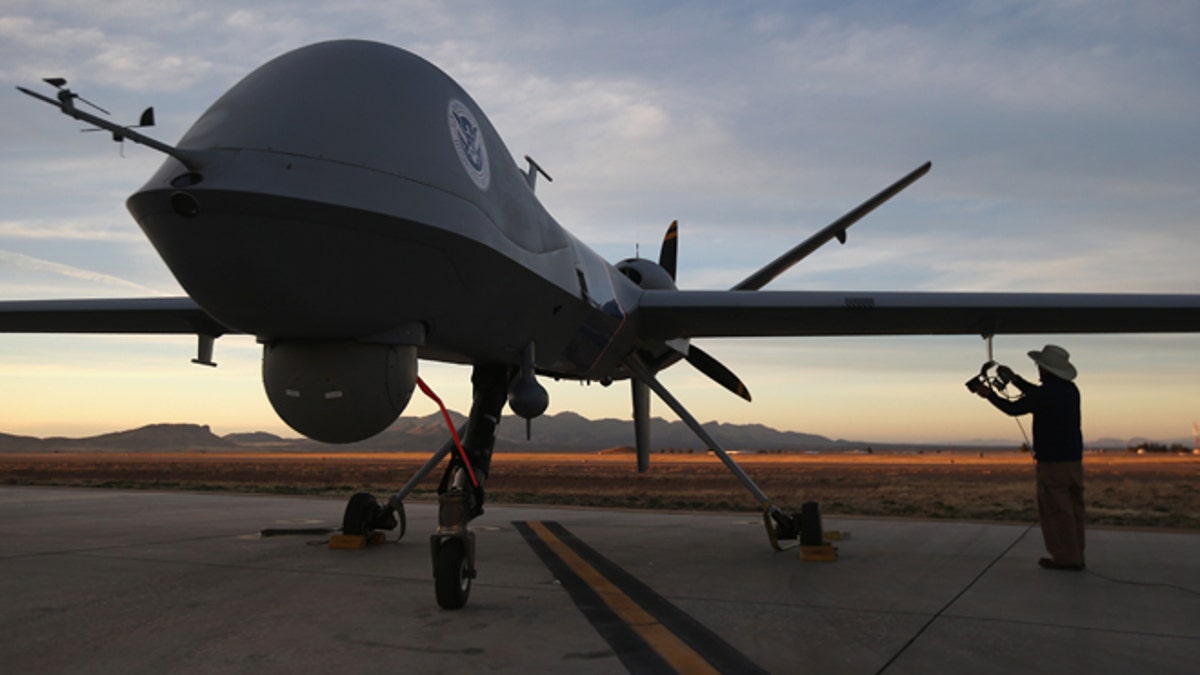
Maintenence personel check a Predator drone operated by U.S. Office of Air and Marine (OAM), before its surveillance flight near the Mexican border on March 7, 2013 from Fort Huachuca in Sierra Vista, Arizona. (Photo by John Moore/Getty Images) (2013 Getty Images)
Attacks by U.S. unmanned drones in the Middle East and Africa are commonplace, but it would be unheard of to see these aerial military weapons appearing over the U.S.-Mexico border.
Yet it's a possible scenario, according to a newly-unearthed document from the country's leading federal border agency, U.S. Customs and Border Protection.
According to a Customs and Border Protection report obtained by the Electronic Frontier Foundation through a Freedom of Information Act lawsuit, the agency has considered adding weapons to its Predator drones that currently serve as the agency's eyes in the sky on the lookout for undocumented immigrants and drug trafficking coming across the border.
A section of the heavily redacted 107-page report that deals with the equipment mounted on the drones states that “Additional payload upgrades could include expendables or non-lethal weapons designed to immobilize [targets of interest].”
The federal border agency downplayed the report, saying it has no plans as of now to arm its drones, adding that current missions focus solely on surveillance and reporting illegal activity.
"CBP has no plans to arm its unmanned aircraft systems with non-lethal weapons or weapons of any kind," the agency said in a statement to Fox News Latino. "CBP’s unmanned aircraft systems (UAS) support CBP’s border security mission and provide an important surveillance and reconnaissance capability for interdiction agents on the ground and on the waterways."
But the statement left the door open for a possible policy change, noting the drones have the capability to be armed: "Current UAS were designed with the ability to add new surveillance capabilities, accommodate technological developments, and ensure that our systems are equipped with the most advanced resources available."
While the CBP report does not go into any specifics on what type of “non-lethal weapons” could be equipped on the Predators or the likelihood that they will be eventually weaponized, the mere option in and of itself raised eyebrows.
The discovery angered anti-drone activists who worry about mishaps like those in Pakistan and Yemen. A number of drone strikes in those areas have accidentally killed innocent people or mistaken their targets, leading to an uproar from the government in Islamabad and religious leaders in Sana’a.
“This is all too reminiscent of drone use overseas, it’s covert, it leads down the slippery slope toward lethal use,” Madea Benjamin, the founder of Global Drones Watch and the author of Drone Warfare: Killing By Remote Control, told Fox News Latino in an interview.
“If we start down this path we could be led down a path of innocent people being killed by drones along the border.” Benjamin added.
The use of drones along the U.S. borders with Canada and Mexico began several years ago. CBP currently has eight Predators in the skies along the northern and southern borders with an additional two drones patrolling the Caribbean.
The drones don't currently have weapons, just high-tech cameras used only for surveillance purposes. But critics of the use of drones for border security have used agency statistics to show the machines are not cost-effective because they lead to a relatively small number of migrant arrests and drug seizures.
Whether or not the government is seriously considering arming drones, some analysts questioned the motive for such a move. There may be some logic to it, analysts said, but it surely would come loaded with controversy.
“It seems pretty awful, the idea of armed drones on the border,” said Christopher Wilson, an associate at the Washington-based think tank the Woodrow Wilson International Center for Scholars.
“On the other hand, the Border Patrol is an armed agency and there have been a number of incidents of violence between agents and people along the border, so non-lethal weapons might not be such a bad idea," Wilson added.
But the anti-drone activists are not buying it.
Benjamin argued that there have been many incidents when “non-lethal weapons” such as rubber bullets have turned deadly, including in Northern Ireland and between Israeli and Palestinian forces. The CBP report, however, does not specify what type of weaponry could be mounted on the Predator drones.
“Any of these things can be deadly,” Benjamin said. “This is something we have to look at and discuss before anything can be allowed to be put on these drones.”
It remains to be seen what the government actually does -- sometimes ideas in reports stay as just words on a page, while other times it might get the attention of an influential lawmaker that takes it on as a personal cause célèbre.
“Lawmakers think up a lot of ideas. Few of them make it to paper and even fewer of them are implemented,” Wilson said.
